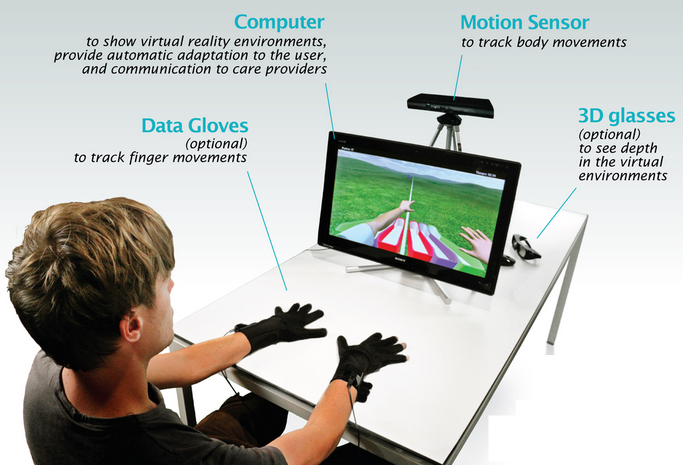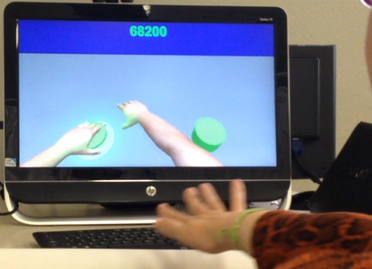Virtual-reality display allows stroke patients to spontaneously recover use of paralyzed arm
June 9, 2015

Virtual-reality Rehabilitation Gaming System (credit: Belén Rubio Ballester)
In a clinical study, Spanish researchers have used a Microsoft Kinect to help stroke patients increase their ability to use a paralyzed arm.
Stroke patients with “hemiparesis” —- reduced muscle strength on one side of the body — often under-use their affected limbs even though they still have some motor function. A long period of non-use of the affected “paretic” limb can lead to further loss of function.
The small pilot study involved 20 hemiparetic stroke patients using the developer’s Rehabilitation Gaming System. The Kinect camera detect the patient’s arm position and movements. The system allows patients to control a virtual body (seen on a computer monitor) with their own movements.

Rehabilitation Gaming System in use (credit: Belén Rubio Ballester)
Participants were asked to reach targets appearing in a virtual environment over several trials. In some of these trials, the researchers enhanced the movement of the paretic limb’s virtual representation, making it appear faster, more accurate, and easier to reach the target on screen.
These amplifications were introduced and suppressed in a gradual fashion to keep participants unaware of the manipulations. The participants’ performance without the enhancement were then recorded.
“After enhancement of movement, patients started using their paretic limb more frequently,” said Belén Rubio from the Laboratory of Synthetic, Perceptive, Emotive and Cognitive Systems, Universitat Pompeu Fabra, Spain.
Beliefs trump restraint
“This suggests that changing patients’ beliefs on their capabilities significantly improves the use of their paretic limb. Surprisingly, only ten minutes of enhancement was enough to induce significant changes in the amount of spontaneous use of the affected limb.”
Following the intervention, there was a significantly higher probability that the patient would select their paretic limb for reaching towards a virtual target. Patients did not report awareness of the previous session’s manipulation.
Some current therapies for stroke patients involve forcing the patient to use the affected limb by constraining movement of the healthy limb. The new study suggests that an alternative focus on increasing the patient’s confidence in using the paretic arm may instead be critical for full recovery.
The study will need to be repeated with a larger number of participants to provide more insight into the use of the RGS-based virtual reality intervention as an effective therapy.
The research was published in the open-access Journal of NeuroEngineering and Rehabilitation. RGS is being commercialized by spin-off company Eodyne.com.
Abstract of The visual amplification of goal-oriented movements counteracts acquired non-use in hemiparetic stroke patients
Background
Stroke-induced impairments result from both primary and secondary causes, i.e. damage to the brain and the acquired non-use of the impaired limbs. Indeed, stroke patients often under-utilize their paretic limb despite sufficient residual motor function. We hypothesize that acquired non-use can be overcome by reinforcement-based training strategies.
Methods
Hemiparetic stroke patients (n = 20, 11 males, 9 right-sided hemiparesis) were asked to reach targets appearing in either the real world or in a virtual environment. Sessions were divided into 3 phases: baseline, intervention and washout. During the intervention the movement of the virtual representation of the patients’ paretic limb was amplified towards the target.
Results
We found that the probability of using the paretic limb during washout was significantly higher in comparison to baseline. Patients showed generalization of these results by displaying a more substantial workspace in real world task. These gains correlated with changes in effector selection patterns.
Conclusions
The amplification of the movement of the paretic limb in a virtual environment promotes the use of the paretic limb in stroke patients. Our findings indicate that reinforcement-based therapies may be an effective approach for counteracting learned non-use and may modulate motor performance in the real world.